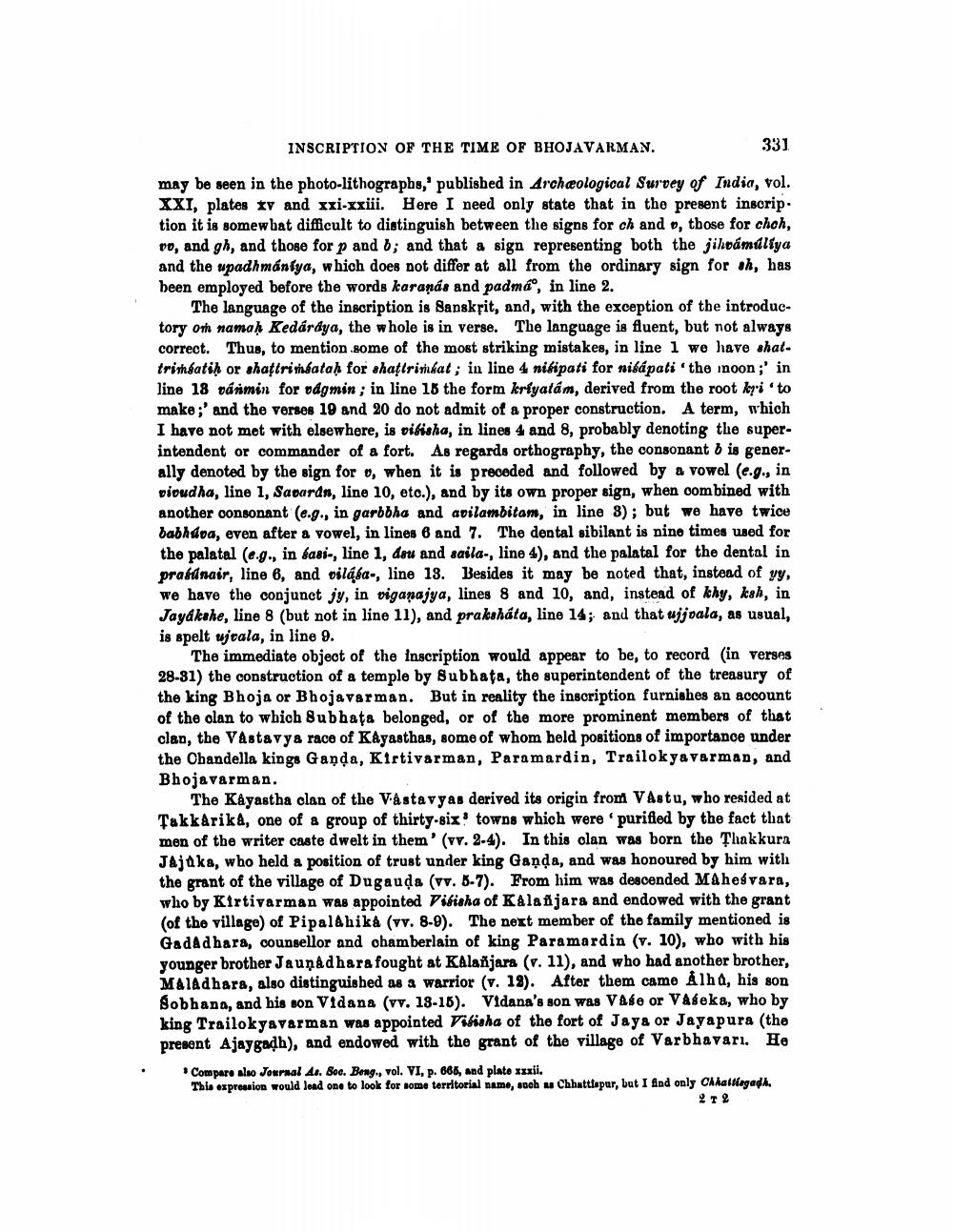________________
INSCRIPTION OF THE TIME OF BHOJAVARMAN.
331
may be seen in the photo-lithographs, published in Archeological Survey of India, Vol. XXI, plates tv and xxi-xxii. Here I need only state that in the present inscrip. tion it is somewbat difficult to distinguish between the signs for ch and , those for cheh, no, and gh, and those for p and b; and that a sign representing both the jilwamaliya and the wpadhmántya, which does not differ at all from the ordinary sign for oh, has been employed before the words karanas and padma', in line 2.
The language of the inscription is Sanskrit, and, with the exception of the introductory om namah Kedardya, the whole is in verse. The language is fluent, but not always correct. Thus, to mention.some of the most striking mistakes, in line 1 we have shattriméatih or shattrinbatah for shattrinkat; in line 4 nisipati for niéápati 'the inoon;' in line 18 vármin for udgmin; in line 18 the form kriyatam, derived from the root ky'i 'to make;' and the verses 19 and 20 do not admit of a proper construction. A term, which I have not met with elsewhere, is difisha, in lines 4 and 8, probably denoting the superintendent or commander of a fort. As regards orthography, the consonant 6 is generally denoted by the sign for o, when it is preceded and followed by a vowel (e.g., in vioudha, line 1, Savardn, line 10, etc.), and by its own proper sign, when combined with another consonant (e.g., in garbbha and apilambitam, in line 3); but we have twice babhdoa, even after a vowel, in lines 6 and 7. The dental sibilant is nine times used for the palatal (e.g., in basi-, line 1, deu and saila-, line 4), and the palatal for the dental in prafdnair, line 6, and vilála-, line 13. Besides it may be noted that, instead of yy, we have the conjunct jy, in viganajya, lines 8 and 10, and, instead of thy, ksh, in Jayd kahe, line 8 (but not in line 11), and praksháta, line 14; and that ujjoala, as usual, is spelt wjtala, in line 9.
The immediate object of the Inscription would appear to be, to record in verses 28-31) the construction of a temple by Subhata, the superintendent of the treasury of the king Bhoja or Bhojavarman. But in reality the inscription furnishes an account of the olan to which Subhata belonged, or of the more prominent members of that clan, the Vastavy a race of Kayasthas, some of whom held positions of importance under the Chandella kings Ganda, Kirtivarman, Paramardin, Trailokyavarman, and Bhojavarman.
The Kayastha clan of the Vastavyas derived its origin from Vastu, who resided at Takkarika, one of a group of thirty-six towns which were purified by the fact that men of the writer caste dwelt in them' (vv. 2-4). In this olan was born the Thakkura JAjaka, who held a position of trust under king Ganda, and was honoured by him with the grant of the village of Dugauda (vv. 6-7). From him was descended Mahes vara, who by Kirtivarman was appointed Dibisha of Kalajara and endowed with the grant
of the village) of Pipalahika (vv. 8-9). The next member of the family mentioned is GadAdhara, counsellor and chamberlain of king Paramardin (v. 10), who with his younger brother Jaunadhara fought at Kalañjara (v. 11), and who had another brother, Maladhara, also distinguished as a warrior (v. 19). After them came Ålha, his son sobhana, and his son Vidana (vv. 18-16). Vidana's son was Vase or Vaseka, who by king Trailokyavarman was appointed Vibisha of the fort of Jaya or Jayapura (the present Ajaygadh), and endowed with the grant of the village of Varbhavarı. He
Compare also Journal 4.. Soc. Bong., vol. VI, p. 666, and plato xxxii. This expression would load one to look for some territorial name, sbohu Chhatttapur, but I find only Challagada.
2 T2




